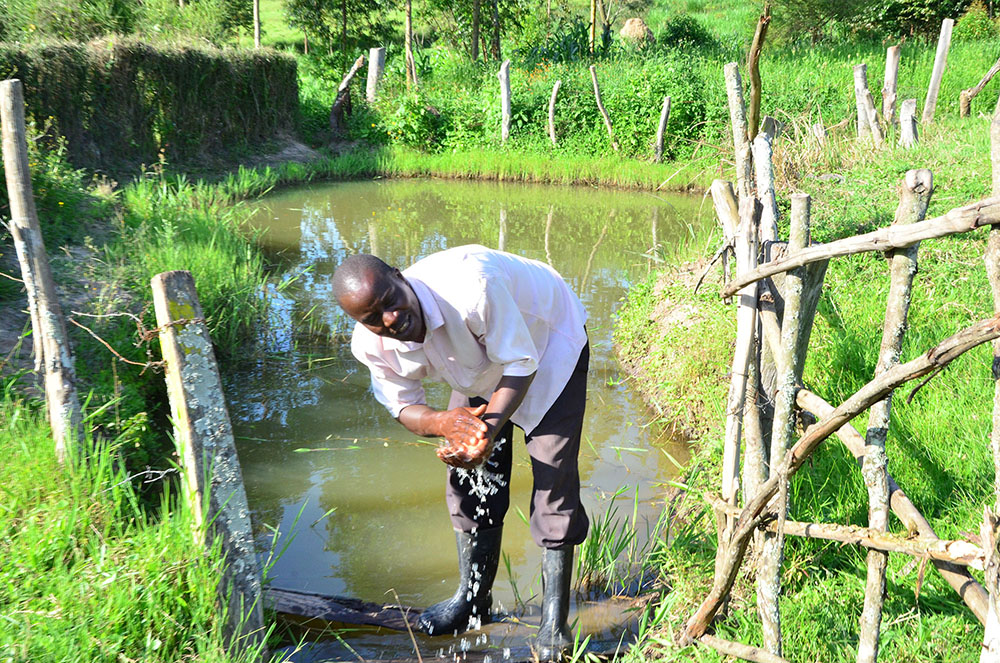When you meet him for the first time, Richard Kansiime reminds you of the agricultural officers of yesteryears. What with his enthusiasm and articulate explanations on issues about farming and progressive agriculture. It is no surprise that the soft-spoken agripreneur is a household name in Igorora town council and Ibanda district.
The 45-year-old resident of Ntungamo cell in Igorora town, Ibanda South County in Ibanda district, has over the past 25 years amassed a body of knowledge on commercial agriculture that has enabled him to build a multi-million agribusiness empire.
Kansiime operates three main agri-enterprises – poultry, piggery and dairy farming. Starting out with two local breed cows, he is now a sought-after model farmer and trainer in all three sub-sectors.
The multi-enterprise farmer earns about sh80m per annum from his commercial farming ventures. The agripreneur earns sh1.8m per month from milk. He gets sh10m is from piggery unit every year. Eggs rake in sh144,000 daily or about sh4m per month.
His projects sit on about 62 acres of land, most of which was acquired using proceeds from the farming. Kansiime has been selected as one of the eight farmers to pilot the parish development model in Igorora town council, a move that will ensure the district fully taps into his resourcefulness in agribusiness.
Starting out
Kansiime is a self-made man. He never let challenges cloud his aspirations. The model farmer has largely built his farming enterprise on determination and drive to succeed in life, says Tito Mugabe, the former agriculture officer for Igorora town council, who has worked with Kansiime for over two years now. Mugabe is now the Rwenkobwa town council (Ibanda North County) agriculture officer.
The agripreneur dropped out of school in Primary Five due to lack of school fees. The inheritance of two local breed cows from his father in 1994 marked his journey into livestock production. He sold off the cows in 1996 at sh1.8m and bought two cross-breed cows, which ushered him into dairy farming. From a couple of litres of milk when he was starting out, Kansiime presently produces about 75 litres per day.
“When I realised that the cows were bringing good cash, I decided to start making silage to supplement their feeding and boost milk production,” he said.
The move paid off as milk output at one time hit almost 100 litres daily from six cows on the back of good feeding and care. Of the milk produced daily, the farmer sells 70 litres to Igorora Dairy Farmers Association, earning sh2.8m per month. A litre of milk is at sh1,400 presently in Ibanda.
Kansiime prefers to sell the milk through the local farmer co-operative because it offers good rates and pays farmers timely.
Currently, he has 11 dairy cattle of the Friesian breed. Six of these are cows, of which four are milking. Three are female calves, one heifer and one male bovine (young bull).
The model farmer says he always sells off bulls at eight months old for sh1.2m each. Heifers the same age cost sh2m while in-calf heifers are at about sh3.5m and mature cows go for up to sh6m, depending on size and breed, according to Kansiime.
Challenges
Fake acaricides and drugs are a major challenge for Kansiime. He explains that has him in terms of drugs to treat tick-borne diseases.
Moreover, the expensive vet drugs eat into his returns. He calls on the Government to protect farmers by apprehending the unscrupulous dealers selling of fake and substandard drugs.
The common cattle diseases on the farm are east coast fever, lump skin and mastitis, he says.
Low milk prices that at times reach sh450 per litre also affect his business.
There is also the high cost of modern equipment to make silage. Kansiime uses a small “Katwe made” machine to make silage.
“So, the government should subsidise dairy farmers to buy better machines for quality silage-making. This will boost milk production,” he says.
I operate a hybrid approach of semi-zero grazing because I cannot afford good equipment to make silage, he adds. The agripreneur has three acres of land where he grows maize and eight others under napier for making silage. However, without crop irrigation, the long dry spells always exhaust his silage stocks.

Advice
- Get involved in all farm activities and supervise the workers to guard against lapses that could compromise feeding routines and treatment regimes and hence expose animals to health risks.
- Ensure proper feeding for good milk production.
- Consult vets in case of disease outbreaks and any other health challenges at the farm.
- Select good breeds.
Next we shall delve more into Kansiime’s other ventures such as poultry and piggery





